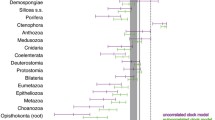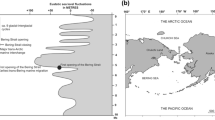Abstract
Cyanobacteria are known to play important roles in driving biological and geochemical innovations in ancient Earth. The origin of Cyanobacteria is the key to understanding these evolutionary events and thus has gained much interest to biologists and geobiologists. Recent development of the molecular dating approaches provides us an opportunity to assess the timeline of Cyanobacteria evolution based on relaxed clock models. The implementation of Bayesian phylogenetic approaches accommodates the uncertainties from different sources, such as fossil calibrations and topological structure of the phylogenomic tree, and provides us converged estimates of posterior mean ages. In this chapter, by taking Cyanobacteria as an example, we introduce a refined strategy to perform molecular dating analysis, as well as a practical method to evaluate the precision of dating analysis.
Access this chapter
Tax calculation will be finalised at checkout
Purchases are for personal use only
Similar content being viewed by others
References
Luo G, Ono S, Beukes NJ, Wang DT, Xie S, Summons RE (2016) Rapid oxygenation of Earth’s atmosphere 2.33 billion years ago. Sci Adv 2(5):e1600134
Sánchez-Baracaldo P, Cardona T (2020) On the origin of oxygenic photosynthesis and Cyanobacteria. New Phytol 225(4):1440–1446
Shih PM, Hemp J, Ward LM, Matzke NJ, Fischer WW (2017) Crown group Oxyphotobacteria postdate the rise of oxygen. Geobiology 15(1):19–29
Zuckerkandl E, Pauling L (1962) Molecular disease, evolution, and genetic heterogeneity. In: Kasha M, Pullman B (eds) Horizons in biochemistry. Academic Press, New York
Sanderson MJ (1997) A nonparametric approach to estimating divergence times in the absence of rate constancy. Mol Biol Evol 14(12):1218–1231
Drummond AJ, Ho SYW, Phillips MJ, Rambaut A (2006) Relaxed phylogenetics and dating with confidence. PLoS Biol 4(5):e88
Rannala B, Yang Z (2007) Inferring speciation times under an episodic molecular clock. Syst Biol 56(3):453–466
Lartillot N, Lepage T, Blanquart S (2009) PhyloBayes 3: a Bayesian software package for phylogenetic reconstruction and molecular dating. Bioinformatics 25(17):2286–2288
Dos Reis M, Donoghue PC, Yang Z (2016) Bayesian molecular clock dating of species divergences in the genomics era. Nat Rev Genet 17(2):71–80
Ho SY, Duchêne S (2014) Molecular-clock methods for estimating evolutionary rates and timescales. Mol Ecol 23(24):5947–5965
Fu L, Niu B, Zhu Z, Wu S, Li W (2012) CD-HIT: accelerated for clustering the next-generation sequencing data. Bioinformatics 28(23):3150–3152
Emms DM, Kelly S (2015) OrthoFinder: solving fundamental biases in whole genome comparisons dramatically improves orthogroup inference accuracy. Genome Biol 16(1):1–14
Foster PG, Hickey DA (1999) Compositional bias may affect both DNA-based and protein-based phylogenetic reconstructions. J Mol Evol 48(3):284–290
Darriba D, Taboada GL, Doallo R, Posada D (2011) ProtTest 3: fast selection of best-fit models of protein evolution. Bioinformatics 27(8):1164–1165
Foster PG (2004) Modeling compositional heterogeneity. Syst Biol 53(3):485–495
Nguyen LT, Schmidt HA, von Haeseler A, Minh BQ (2014) IQ-TREE: a fast and effective stochastic algorithm for estimating maximum-likelihood phylogenies. Mol Biol Evol 32(1):268–274
Junier T, Zdobnov EM (2010) The Newick utilities: high-throughput phylogenetic tree processing in the UNIX shell. Bioinformatics 26(13):1669–1670
Schirrmeister BE, Sanchez-Baracaldo P, Wacey D (2016) Cyanobacterial evolution during the Precambrian. Int J Astrobiol 15(3):187–204
Schirrmeister BE, de Vos JM, Antonelli A, Bagheri HC (2013) Evolution of multicellularity coincided with increased diversification of cyanobacteria and the great oxidation event. Proc Natl Acad Sci USA 110(5):1791–1796
Golubic S, Sergeev VN, Knoll AH (1995) Mesoproterozoic Archaeoellipsoides: akinetes of heterocystous cyanobacteria. Lethaia 28(4):285–298
Sergeev V, Gerasimenko L, Zavarzin G (2002) The proterozoic history and present state of cyanobacteria. Microbiology 71(6):623–637
Crowe SA, Døssing LN, Beukes NJ, Bau M, Kruger SJ, Frei R, Canfield DE (2013) Atmospheric oxygenation three billion years ago. Nature 501(7468):535–538
Mojzsis SJ, Arrhenius G, McKeegan KD, Harrison TM, Nutman AP, Friend CRL (1996) Evidence for life on earth before 3,800 million years ago. Nature 384(6604):55–59
Yang Z, Rannala B (2005) Bayesian estimation of species divergence times under a molecular clock using multiple fossil calibrations with soft bounds. Mol Biol Evol 23(1):212–226
Battistuzzi FU, Hedges SB (2008) A major clade of prokaryotes with ancient adaptations to life on land. Mol Biol Evol 26(2):335–343
Katoh K, Misawa K, Ki K, Miyata T (2002) MAFFT: a novel method for rapid multiple sequence alignment based on fast Fourier transform. Nucleic Acids Res 30(14):3059–3066
Yang Z (2007) PAML 4: phylogenetic analysis by maximum likelihood. Mol Biol Evol 24(8):1586–1591
dos Reis M, Yang Z (2019) Bayesian molecular clock dating using genome-scale datasets. In: Anisimova M (ed) Evolutionary genomics. Methods in molecular biology, vol 1910. Humana, New York
Reis M, Yang Z (2011) Approximate likelihood calculation on a phylogeny for Bayesian estimation of divergence times. Mol Biol Evol 28(7):2161–2172
Capella-Gutiérrez S, Silla-Martínez JM, Gabaldón T (2009) trimAl: a tool for automated alignment trimming in large-scale phylogenetic analyses. Bioinformatics 25(15):1972–1973
Yang Z, Rannala B (2006) Bayesian estimation of species divergence times under a molecular clock using multiple fossil calibrations with soft bounds. Mol Biol Evol 23(1):212–226
Tao Q, Barba-Montoya J, Kumar S (2021) Data-driven speciation tree prior for better species divergence times in calibration-poor molecular phylogenies. Bioinformatics 37(Supplement_1):i102–i110
Brown RP, Yang Z (2011) Rate variation and estimation of divergence times using strict and relaxed clocks. BMC Evol Biol 11(1):1–12
Dos Reis M, Thawornwattana Y, Angelis K, Telford MJ, Donoghue PC, Yang Z (2015) Uncertainty in the timing of origin of animals and the limits of precision in molecular timescales. Curr Biol 25(22):2939–2950
Reis MD, Gunnell GF, Barba-Montoya J, Wilkins A, Yang Z, Yoder AD (2018) Using phylogenomic data to explore the effects of relaxed clocks and calibration strategies on divergence time estimation: primates as a test case. Syst Biol 67(4):594–615
Welch JJ, Bromham L (2005) Molecular dating when rates vary. Trends Ecol Evol 20(6):320–327
Dittrich D, Leenders RTA, Mulder J (2019) Network autocorrelation modeling: a Bayes factor approach for testing (multiple) precise and interval hypotheses. Sociol Methods Res 48(3):642–676
Dos Reis M, Yang Z (2013) The unbearable uncertainty of Bayesian divergence time estimation. J Syst Evol 51(1):30–43
Sauquet H (2013) A practical guide to molecular dating. Comptes Rendus Palevol 12(6):355–367
Boden JS, Konhauser KO, Robbins LJ, Sánchez-Baracaldo P (2021) Timing the evolution of antioxidant enzymes in cyanobacteria. Nat Commun 12(1):1–12
Sánchez-Baracaldo P (2015) Origin of marine planktonic cyanobacteria. Sci Rep 5:17418
Sánchez-Baracaldo P, Ridgwell A, Raven JA (2014) A neoproterozoic transition in the marine nitrogen cycle. Curr Biol 24(6):652–657
Sánchez-Baracaldo P, Raven JA, Pisani D, Knoll AH (2017) Early photosynthetic eukaryotes inhabited low-salinity habitats. Proc Natl Acad Sci USA 114(37):E7737–E7745
Falcón LI, Magallón S, Castillo A (2010) Dating the cyanobacterial ancestor of the chloroplast. ISME J 4(6):777–783
Schirrmeister BE, Gugger M, Donoghue PC (2015) Cyanobacteria and the great oxidation event: evidence from genes and fossils. Palaeontology 58(5):769–785
Dos Reis M, Donoghue PC, Yang Z (2014) Neither phylogenomic nor palaeontological data support a Palaeogene origin of placental mammals. Biol Lett 10(1):20131003
Morris JL, Puttick MN, Clark JW, Edwards D, Kenrick P, Pressel S, Wellman CH, Yang Z, Schneider H, Donoghue PC (2018) Reply to Hedges et al.: accurate timetrees do indeed require accurate calibrations. Proc Natl Acad Sci 115(41):E9512–E9513
Marshall CR (2019) Using the fossil record to evaluate Timetree timescales. Front Genet 10:1049
William Schopf J (2011) The paleobiological record of photosynthesis. Photosynth Res 107(1):87–101
Zhang H, Sun Y, Zeng Q, Crowe SA, Luo H (2021) Snowball earth, population bottleneck and Prochlorococcus evolution. Proc R Soc B Biol Sci 288(1963):20211956
Nisbet EG, Sleep NH (2001) The habitat and nature of early life. Nature 409(6823):1083–1091
Wang S, Luo H (2021) Dating Alphaproteobacteria evolution with eukaryotic fossils. Nat Commun 12(1):1–9
Warnock RC, Parham JF, Joyce WG, Lyson TR, Donoghue PC (2015) Calibration uncertainty in molecular dating analyses: there is no substitute for the prior evaluation of time priors. Proc R Soc B Biol Sci 282(1798):20141013
Soo RM, Hemp J, Parks DH, Fischer WW, Hugenholtz P (2017) On the origins of oxygenic photosynthesis and aerobic respiration in cyanobacteria. Science 355(6332):1436–1440
Bekker A, Holland H, Wang P-L, Rumble D, Stein H, Hannah J, Coetzee L, Beukes N (2004) Dating the rise of atmospheric oxygen. Nature 427(6970):117–120
Wolfe JM, Fournier GP (2018) Horizontal gene transfer constrains the timing of methanogen evolution. Nat Ecol Evol 2(5):897–903
Davín AA, Tannier E, Williams TA, Boussau B, Daubin V, Szöllősi GJ (2018) Gene transfers can date the tree of life. Nat Ecol Evol 2(5):904–909
Magnabosco C, Moore KR, Wolfe JM, Fournier GP (2018) Dating phototrophic microbial lineages with reticulate gene histories. Geobiology 16(2):179–189
Acknowledgments
This work is supported by the Southern Marine Science and Engineering Guangdong Laboratory (Guangzhou) (SMSEGL20SC02) and Hong Kong Research Grants Council General Research Fund (14110820).
Author information
Authors and Affiliations
Editor information
Editors and Affiliations
Data Availability
Data Availability
The custom scripts as well as the genome set of Cyanobacteria are available in the online GitHub repository (https://github.com/luolab-cuhk/MMB_Cyano_dating).
Rights and permissions
Copyright information
© 2022 The Author(s), under exclusive license to Springer Science+Business Media, LLC, part of Springer Nature
About this protocol
Cite this protocol
Zhang, H., Wang, S., Luo, H. (2022). A Computational Protocol for Dating the Evolution of Cyanobacteria. In: Luo, H. (eds) Environmental Microbial Evolution. Methods in Molecular Biology, vol 2569. Humana, New York, NY. https://doi.org/10.1007/978-1-0716-2691-7_2
Download citation
DOI: https://doi.org/10.1007/978-1-0716-2691-7_2
Published:
Publisher Name: Humana, New York, NY
Print ISBN: 978-1-0716-2690-0
Online ISBN: 978-1-0716-2691-7
eBook Packages: Springer Protocols




